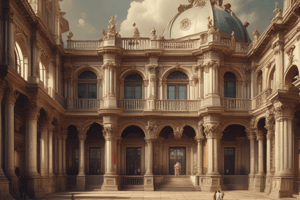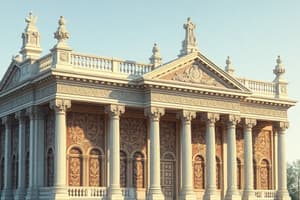Podcast
Questions and Answers
What architectural style emphasizes functional design and a synthesis of technology, craft, and design aesthetics?
What architectural style emphasizes functional design and a synthesis of technology, craft, and design aesthetics?
- Classical
- Art Deco
- Bauhaus (correct)
- Brutalism
Which architectural style is derived from the principles of Greek and Roman architecture?
Which architectural style is derived from the principles of Greek and Roman architecture?
- Classical (correct)
- Evolutionary Architecture
- Art Nouveau
- Bauhaus
Which architectural style is marked by geometric motifs, streamlined forms, and bold colors?
Which architectural style is marked by geometric motifs, streamlined forms, and bold colors?
- Moorish
- NeoClassicism
- Art Deco (correct)
- Rococo
Baroque architecture is characterized by simple geometric forms and large untextured surfaces.
Baroque architecture is characterized by simple geometric forms and large untextured surfaces.
What architectural style emphasizes a balance of forces and the achievement of height and light through skeletal structures and increased windows?
What architectural style emphasizes a balance of forces and the achievement of height and light through skeletal structures and increased windows?
______ architecture is characterized by the synthesis of technology, craft, and design aesthetics.
______ architecture is characterized by the synthesis of technology, craft, and design aesthetics.
Match the architectural style with its description:
Match the architectural style with its description:
Which architectural style emphasizes designs based on climatic and ecological elements, as well as technological advancements?
Which architectural style emphasizes designs based on climatic and ecological elements, as well as technological advancements?
What architectural style emerged as a reaction against international style and Modernism?
What architectural style emerged as a reaction against international style and Modernism?
Rococo is an architectural style characterized by profuse, semi-abstract ornamentation and associated with ____, swirling forms.
Rococo is an architectural style characterized by profuse, semi-abstract ornamentation and associated with ____, swirling forms.
Flashcards are hidden until you start studying
Study Notes
Architectural Styles
- Bauhaus: Synthesis of technology, craft, and design aesthetics; emphasizes functional design.
- Classical: Derived from principles of Greek and Roman architecture.
Regional Influences
- Moorish: Prevalent in Spain and Morocco; influenced by Mesopotamian brick and stucco techniques; characterized by horseshoe arches and Roman columns and capitals.
Aesthetics and Ornamentation
- Art Deco: Geometric motifs, streamlined and curvilinear forms, sharply defined outlines, and often bold colors.
- Rococo: Characterized by profuse, semi-abstract ornamentation; associated with lightness, swirling forms, flowing lines, ornate stucco work, and arabesque ornament.
- Art Nouveau: Characterized by fluid, undulating motifs, often derived from natural forms.
Design Philosophy
- Evolutionary Architecture: Designs that grow and develop based on climatic and ecological elements, as well as advances in technology; approached as a living organism.
- Organic Architecture: Emphasizes personal freedom; harmony between structure and the environment; integration of individual parts to the whole concept; all forms should express the natural use of materials.
Historical Styles
- Romanesque: Characterized by massive articulated wall structures, arches, and powerful vault; emerged from Roman and Byzantine elements.
- Gothic: Characterized by a delicate balance of forces, with thrusts directed throughout a rigid structural lattice; features height and light, achieved through a mixture of skeletal structures and ever-increasing windows.
- Renaissance: Characterized by using classical orders, round arches, and symmetrical proportions; developed during the rebirth of classical art and learning in Europe.
- Baroque: More ornate than the Renaissance style; deliberate in its attempt to impress, and was lavish of all styles, both in its use of materials and in the effects it achieves.
Modernist and Postmodernist Movements
- International Style: Characterized by simple geometric forms, large untextured, often white surfaces, large areas of glass, and general use of steel or reinforced concrete construction.
- Postmodernism: Reaction against international style and Modernism; encourages the use of elements from historical vernacular styles and often a playful illusion, decoration, and complexity.
- Deconstructivism: Questions traditional assumptions and takes modernist abstraction to an extreme; exaggerates already known motifs.
- Conceptual Architecture: "Invisible" or "imaginary" architecture; represents plans and drawings for buildings and cities that have never been constructed; pure research or speculation.
Other Styles
- Brutalism: Emphasizes the aesthetic use of basic building processes, especially cast-in-place concrete, with no apparent concern for visual amenity.
- Expressionism: Treats buildings as sculptural objects, not only as functional structures.
- Neoclassicism: Marked by monumentality, strict use of the orders, and sparing application of ornament.
Architectural Styles
- Bauhaus: Synthesis of technology, craft, and design aesthetics; emphasizes functional design.
- Classical: Derived from principles of Greek and Roman architecture.
Regional Influences
- Moorish: Prevalent in Spain and Morocco; influenced by Mesopotamian brick and stucco techniques; characterized by horseshoe arches and Roman columns and capitals.
Aesthetics and Ornamentation
- Art Deco: Geometric motifs, streamlined and curvilinear forms, sharply defined outlines, and often bold colors.
- Rococo: Characterized by profuse, semi-abstract ornamentation; associated with lightness, swirling forms, flowing lines, ornate stucco work, and arabesque ornament.
- Art Nouveau: Characterized by fluid, undulating motifs, often derived from natural forms.
Design Philosophy
- Evolutionary Architecture: Designs that grow and develop based on climatic and ecological elements, as well as advances in technology; approached as a living organism.
- Organic Architecture: Emphasizes personal freedom; harmony between structure and the environment; integration of individual parts to the whole concept; all forms should express the natural use of materials.
Historical Styles
- Romanesque: Characterized by massive articulated wall structures, arches, and powerful vault; emerged from Roman and Byzantine elements.
- Gothic: Characterized by a delicate balance of forces, with thrusts directed throughout a rigid structural lattice; features height and light, achieved through a mixture of skeletal structures and ever-increasing windows.
- Renaissance: Characterized by using classical orders, round arches, and symmetrical proportions; developed during the rebirth of classical art and learning in Europe.
- Baroque: More ornate than the Renaissance style; deliberate in its attempt to impress, and was lavish of all styles, both in its use of materials and in the effects it achieves.
Modernist and Postmodernist Movements
- International Style: Characterized by simple geometric forms, large untextured, often white surfaces, large areas of glass, and general use of steel or reinforced concrete construction.
- Postmodernism: Reaction against international style and Modernism; encourages the use of elements from historical vernacular styles and often a playful illusion, decoration, and complexity.
- Deconstructivism: Questions traditional assumptions and takes modernist abstraction to an extreme; exaggerates already known motifs.
- Conceptual Architecture: "Invisible" or "imaginary" architecture; represents plans and drawings for buildings and cities that have never been constructed; pure research or speculation.
Other Styles
- Brutalism: Emphasizes the aesthetic use of basic building processes, especially cast-in-place concrete, with no apparent concern for visual amenity.
- Expressionism: Treats buildings as sculptural objects, not only as functional structures.
- Neoclassicism: Marked by monumentality, strict use of the orders, and sparing application of ornament.
Studying That Suits You
Use AI to generate personalized quizzes and flashcards to suit your learning preferences.




